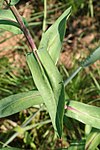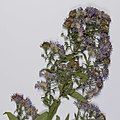Symphyotrichum laeve
| Symphyotrichum laeve | |
|---|---|

| |
| Scientific classification | |
| Kingdom: | Plantae |
| Clade: | Tracheophytes |
| Clade: | Angiosperms |
| Clade: | Eudicots |
| Clade: | Asterids |
| Order: | Asterales |
| Family: | Asteraceae |
| Tribe: | Astereae |
| Subtribe: | Symphyotrichinae |
| Genus: | Symphyotrichum |
| Subgenus: | Symphyotrichum subg. Symphyotrichum
|
| Section: | Symphyotrichum sect. Symphyotrichum
|
| Species: | S. laeve
|
| Binomial name | |
| Symphyotrichum laeve | |
| Varieties[2] | |

| |
| North American distribution[2][3][4] | |
| Synonyms[2] | |
|
Basionym
Alphabetical list
| |
Symphyotrichum laeve (formerly Aster laevis) is a flowering plant native to Canada, the United States, and Coahuila (Mexico). It has the common names of smooth blue aster,[5] smooth aster,[4] smooth-leaved aster, glaucous Michaelmas-daisy[6] and glaucous aster.[4]
Description
Smooth aster is 20 to 70 centimeters (8 to 28 inches) tall.
The
The seeds are
Taxonomy
There are four varieties: Symphyotrichum laeve var. laeve, S. laeve var. geyeri (Geyer's aster[3]), S. laeve var. concinnum, and S. laeve var. purpuratum.[7]
Hybrids with this species and others of the genus have been reported, including three named as follows:[9]
- Symphyotrichum × gravesii between S. laeve var. laeve and S. dumosum;
- Symphyotrichum × versicolor between S. laeve var. laeve and S. novi-belgii var. novi-belgii; and,
- Symphyotrichum × woldenii between S. laeve var. laeve and S. praealtum, which instead may be between S. oolentangiense and S. praealtum.
-
Symphyotrichum × gravesii
-
Symphyotrichum × versicolor
-
Symphyotrichum × woldenii
-
Symphyotrichum subg. Chapmaniana[ref 2]: 133subg. Astropolium[ref 2]: 133subg. Virgulus[ref 1]: 272subg. Symphyotrichum[ref 1]: 267sect. Conyzopsis[ref 1]: 271sect. Occidentales[ref 1]: 271sect. Turbinelli[ref 2]: 133sect. Symphyotrichum[ref 1]: 268Cladogram references
- ^ a b c d e f g h i j k l m n o .
- ^ a b c d e f g h i Semple, J.C.; Heard, S.B.; Brouillet, L. (2002). "Cultivated and Native Asters of Ontario (Compositae: Astereae)". University of Waterloo Biology Series. 41. Ontario: University of Waterloo: 1–134.
- ^ Sugbenus Ascendentes is made up of two allopolyploid species with historic parents from subg. Virgulus and subg. Symphyotrichum.
Distribution and habitat
Symphyotrichum laeve varieties are native to
S. laeve grows in fields, open woods, and along roadsides[10] in rocky or dry soil and full sun.[11]
Ecology
Symphyotrichum laeve blooms in late summer and early fall. It is pollinated by many native bees[10] and attracts butterflies.[11] It is a larval host for the pearl crescent butterfly (Phyciodes tharos).[12][8]
Citations
- ^ NatureServe 2021.
- ^ a b c d e POWO 2019.
- ^ a b c Brouillet et al. 2006, var. geyeri.
- ^ a b c d Brouillet et al. 2020.
- ^ USDA 2014.
- ^ BSBI 2007.
- ^ a b c d e Brouillet et al. 2006.
- ^ a b c d Hilty 2016.
- ^ Brouillet et al. 2006, var. laeve.
- ^ a b TWC Staff 2017.
- ^ a b Missouri Botanical Garden n.d.
- ^ Evergreen 2014.
References
- Brouillet, L.; Desmet, P.; Coursol, F.; Meades, S.J.; Favreau, M.; Anions, M.; Bélisle, P.; Gendreau, C.; Shorthouse, D. (4 September 2020). "Symphyotrichum laeve (Linnaeus) Á. Löve & D. Löve". data.canadensys.net. Database of Vascular Plants of Canada (VASCAN). Retrieved 14 September 2021.
- Brouillet, L.; Semple, J.C.; Allen, G.A.; Chambers, K.L.; Sundberg, S.D. (2006). "Symphyotrichum laeve". In Flora of North America Editorial Committee (ed.). Flora of North America North of Mexico (FNA). Vol. 20. New York and Oxford: Oxford University Press. Retrieved 14 September 2021 – via eFloras.org, Missouri Botanical Garden, St. Louis, MO & Harvard University Herbaria, Cambridge, MA.
- BSBI List 2007 (xls). Botanical Society of Britain and Ireland. Archived from the original (xls) on 26 June 2015. Retrieved 17 October 2014.
- Evergreen (2014). "Plant Detail: Symphyotrichum laeve (smooth blue aster, smooth aster)". Native Plant Database (nativeplants.evergreen.ca). Toronto, Ontario: Evergreen. Archived from the original on 2 February 2017. Retrieved 27 January 2017.
- Hilty, J. (2016). "Smooth Blue Aster (Symphyotrichum laeve)". Illinois Wildflowers (www.illinoiswildflowers.info). Retrieved 30 September 2016.
- Missouri Botanical Garden (n.d.). "Symphyotrichum laeve - Missouri Botanical Garden Plant Finder". www.missouribotanicalgarden.org. St. Louis. Retrieved 27 January 2017.
- NatureServe (2 July 2021). "Symphyotrichum laeve Smooth Blue Aster". explorer.natureserve.org. Arlington, Virginia. Retrieved 17 July 2021.
- POWO (2019). "Symphyotrichum laeve (L.) Á.Löve & D.Löve". powo.science.kew.org. Royal Botanic Gardens, Kew. Retrieved 17 July 2021.
- TWC Staff (2017). "Symphyotrichum laeve". Lady Bird Johnson Wildflower Center (www.wildflower.org). University of Texas at Austin. Retrieved 27 January 2017.
- USDA, NRCS (2014). "Symphyotrichum laeve". The PLANTS Database (plants.usda.gov). Greensboro, North Carolina: National Plant Data Team. Retrieved 6 December 2015.










